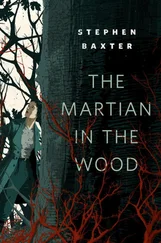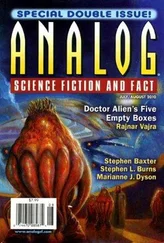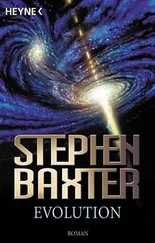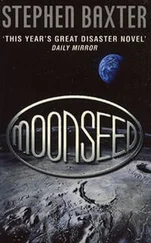Ben said he wanted to go to Earth, to Australia, one last time before he left forever. Madeleine quailed at the idea. That’s not my planet anymore. But she didn’t want to oppose Ben’s complex impulse.
An automated ground-to-orbit shuttle came climbing up to meet them. Nemoto had found someone who had agreed to host them, if briefly.
They skimmed through morning light toward Australia, approaching from the south. They received no calls for identification; there was no attempt at traffic control, nothing from the ground. It was like approaching an uninhabited planet.
They drifted over Sydney. The city was still populated, its suburbs scarred by conflict, but there was no harbor; Sydney had been left beached in the country’s drying interior. The rust-red deserts of the center appeared still more desiccated than before. But she saw no signs of humanity. Alice Springs, for example, was burned out, a husk; nothing moved there.
They skimmed low over the great geological features south of the Alice, Ayers Rock and the Olgas. These were uncompromising lumps of hard, ancient sandstone protruding from the flat desert, extensively carved by megayears of water flows. To the Aborigines, nomads on this unforgiving tabletop landscape, these formations must have been as striking as the medieval cathedrals that had loomed over Europe. And so the Aborigines had made them places of totemic and religious significance, spinning Dreamtime stories from cracks and folds until the rocks became a kind of mythic cinema, frozen in geological time. It had been a triumph of the imagination, she supposed, in a land like a sensory deprivation tank.
This had briefly been a center for tourism. The tourists were long gone now, the Western influence vanished in an instant, a dream of fat and affluence. But the Aborigines had remained. From the air she saw slim figures moving slowly over the landscape, round faces turned up to her vehicle, all as it had been for twelve thousand years — just as Ben had once foreseen, she remembered.
Ben peered from his window, silent, withdrawn.
Perhaps a hundred kilometers south of the Alice, they saw a structure of bright blue, a dot in the desert. A tent.
The shuttle dipped, fell like a brick, and skidded to a halt half a kilometer distant from the tent.
Nobody came to meet them. After a few minutes they climbed down to the ground and walked toward the tent.
The land was an immense orange-red table, the sky a sheet of washed-out blue. There was utter silence here: no bird song, no insects. The Sun was high, ferocious, the heat tremendous and dry. They walked cautiously, unused to Earth’s heavy gravity.
Madeleine felt overwhelmed. Save for a few space walks, it was the first time she had been out of a cramped hab module, out in a landscape, for years.
Ben touched her arm. She stopped. Through the heat haze of the horizon, something moved, stately, silent.
“It looks like a lizard,” she whispered. “A komodo dragon, maybe. But—”
“But it’s immense.”
“Another Gaijin experiment, you think?”
“I think we ought to keep still,” he said.
The lizard, a Mesozoic nightmare, paused for long seconds, perhaps a minute, a tongue the length of a whip lashing out at something unseen. Then it moved on, turning away from the humans.
They hurried on.
Their host was a woman: an American, small, compact, stern-faced, her thick black hair tied back severely behind her head. She was dressed in a silvery coverall. She was called Carole Lerner.
Lerner looked them up and down contemptuously. “Nemoto told me to expect you. She didn’t tell me you were two babes in the wood.” She eyed them with hard suspicion. “I have a hoard.”
Ben frowned. “What?”
Lerner said. “I’m not about to tell you where. If I die my caches will self-destruct.”
Madeleine understood quickly. Medicine had collapsed, along with everything else, when the ice had come. So no more antiaging treatments. Such supplies had become the most precious items on the planet. She held up her hands. “We’re no threat to you, Carole.”
Lerner kept watching them.
At last, sternly, she brought them into the tent, which was blessedly cool, the air moist. She dug out a couple of coveralls, indicated they should put them on. “These are priceless. Literally. Therm-aware clothing, all but indestructible. Nobody makes them anymore. People hand them down like heirlooms, mother to child. Be careful with them.”
“We will,” Madeleine promised.
The tent had no partitions. Ben shrugged, stripped naked, and climbed into his coverall. Madeleine followed suit.
Lerner began to boil water for a drink, and she gave them food: a rehydrated soup, its flavor unidentifiable. She looked about sixty. She was in fact much older than that. She turned out to be the Carole Lerner, the woman who had — following another project of Nemoto’s — descended into the clouds of Venus and become the first, and only, human to set foot there.
Ben glanced around, at piles of rock samples, data discs, a few old-fashioned paper books, heavily thumbed, their pages dusty and yellowed.
“My work,” Lerner growled, watching him. “I’m a geologist. No previous generation has lived through the onset of an Ice Age.”
“Are there still journals, science institutes, universities?” Ben asked.
“Not on Earth,” Lerner said, scowling. “I’m caching my samples and notes. Buried deep enough so the animals can’t get ’em. And I post my results and interpretation to the Moon, Mars.” She eyed Madeleine, hostile. “I know what you’re thinking. I’m some old nut, an obsessive. Science doesn’t matter anymore. You star travelers make me sick. You hop and skip through history, and you don’t see a damn thing. I’ll tell you this. The Gaijin work on long time scales. We’re mayflies to them. And that’s why science matters now. More than ever. So we can stay in the game.”
Madeleine raised her hands. “I didn’t…”
But Lerner had turned her attention to her soup, her anger subsiding. Ben touched Madeleine’s arm, and she fell silent.
This is a woman, she thought, who has spent a long time alone.
Lerner had a small car, just a bubble of plastic on a light frame, powered by batteries kept topped up by a big solar-cell array, and with a gigantic tank of water strapped to its roof. The next day she piled them in and drove them west.
After a couple of hours they reached an area that seemed a little less arid. Madeleine saw green vegetation, trees, tufts of grass, birds wheeling. They came to a shallow creek, dry, that Lerner turned to follow. They passed what appeared to be an abandoned farm, burned out.
They climbed a shallow rise, and Lerner slowed the car, let it run forward almost noiselessly. Finally, as they neared the crest, she cut the engine and let the car’s momentum carry it forward in silence.
As they went over the rise, the land opened up before Madeleine.
There was water, a great calm blue pool of it, stretching halfway to the horizon, utterly unexpected in this dry old place. She could actually smell the water. Her soul felt immediately lifted, some primitive instinct responding.
And it took a full minute of looking, of letting her eyes become accustomed to the landscape, before she could see the animals.
There was a herd of what looked like rhinoceros, lumbering cylinders of flesh, jostling clumsily at the water’s edge. But they had no horns. One of them raised a massive head in which small black eyes were embedded like studs. It was quite spectacularly ugly. She saw that it had small, oddly human feet; it trod delicately.
“Diprotodons,” Lerner murmured. “Very common now.”
Madeleine made out kangaroolike creatures of all sizes — bizarre, overblown animals, some so huge it seemed they could barely lift themselves off the ground; but jump they did, in clumsy lollops. There were creatures like ground sloth that Lerner said were a variety of giant wombat.
Читать дальше
Конец ознакомительного отрывка
Купить книгу











